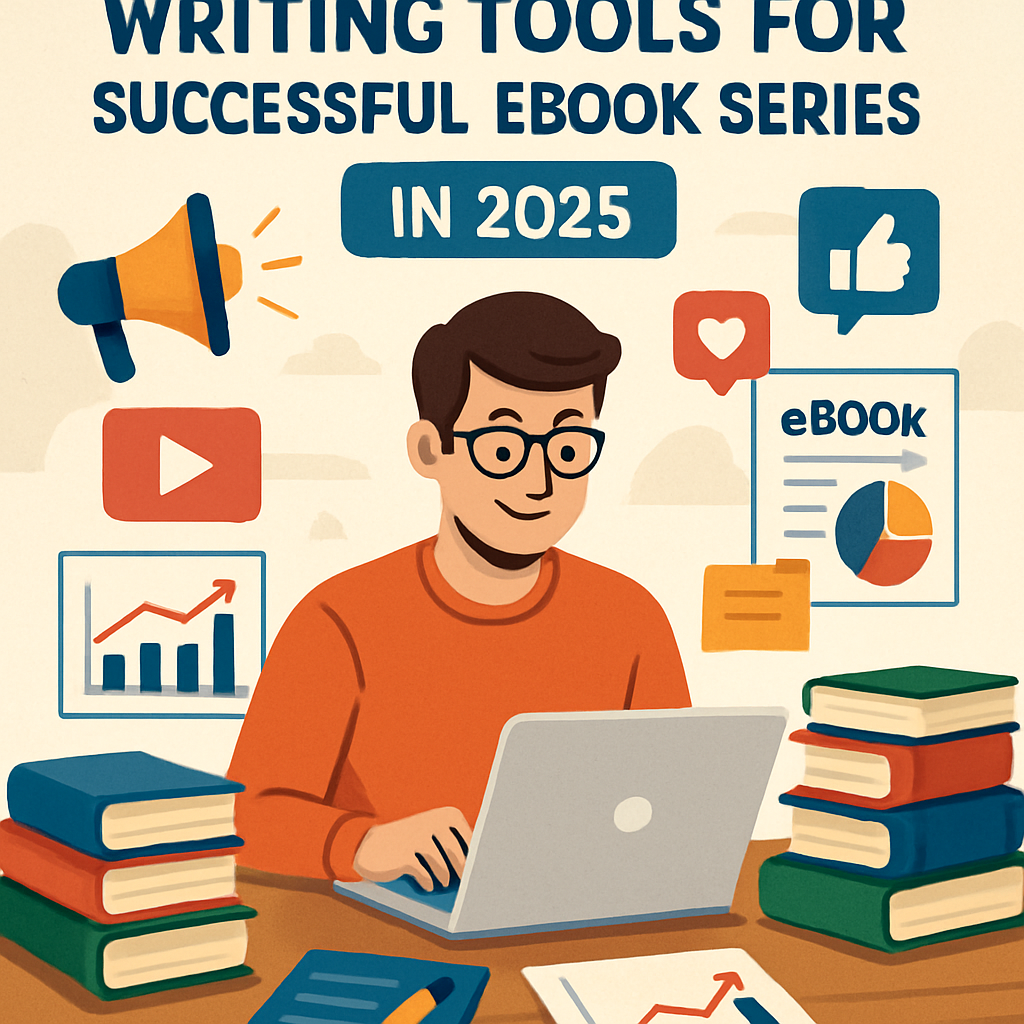Creating a captivating eBook series has become a pivotal strategy for authors eager to establish a loyal readership and earn steady revenue in a competitive digital marketplace. Unlike standalone books, a series opens the door to expansive storytelling, enabling writers to develop complex characters, interwoven plots, and immersive worlds that keep readers returning time after time. In 2025, this approach to eBook writing gains even more significance as digital platforms like Kindle Direct Publishing and Smashwords empower creators to reach audiences worldwide with ease. Harnessing the right planning strategies, character development skills, and marketing knowledge can elevate a series from a simple collection of books to a compelling, unforgettable experience that captivates readers chapter after chapter.
Crafting a successful eBook series requires more than just storytelling talent—it demands meticulous planning and understanding of the market trends, reader preferences, and publishing tools that define today’s digital book ecosystem. With platforms such as Draft2Digital, Kobo Writing Life, and IngramSpark gaining popularity, authors not only need to focus on content but also on distribution and discoverability. Engaging readers goes beyond a captivating narrative; it involves consistent pacing, strong world-building, and smart use of promotional methods like BookFunnel and email marketing. As the ebook landscape advances, the integration of design tools like Canva to create eye-catching covers and promotional materials is becoming indispensable for standing out.
This comprehensive guide will delve into the crucial elements that make an eBook series truly captivating—from initial concept development and crafting memorable characters to sophisticated plotting and immersive world-building. Furthermore, it will illuminate essential writing techniques and cutting-edge marketing strategies that ensure your series not only dazzles readers but also thrives sustainably in a dynamic marketplace. Each section of this article will unpack these components in detail, equipping authors with actionable tips and insights to successfully navigate their journey toward bestselling ebook series creation.
Mastering the Foundation: Planning Your eBook Series for Lasting Impact
Launching a captivating eBook series begins with a strong foundation built on detailed planning and strategic foresight. Authors often overlook this critical phase, rushing into writing without a cohesive vision, which can lead to fragmented stories and disengaged readers. Before opening your word processor, deliberate on your series concept, audience, and the narrative thread that will tie your books together, ensuring that each installment contributes meaningfully to a larger story arc.
Choosing the right niche is fundamental. Consider your passions and market demand; niche topics resonate deeply with targeted audiences and foster dedicated communities. Trend analysis via platforms that track digital book sales can guide you toward themes with high engagement potential. For instance, genres like speculative fiction with nuanced world-building or non-fiction focused on emerging technology continue to flourish. Knowing where your enthusiasm meets reader interest fuels motivation and increases chances of success.
Outlining the entire series structure serves as a roadmap, making it manageable and strategically paced. Decide on the number of books, main themes, and key events. This macro-plan ensures that your plot maintains momentum and cohesiveness. For example, an author might plan a five-book fantasy saga with escalating stakes, culminating in a powerful conclusion that resolves prior mysteries and character arcs.
Understanding your target audience goes beyond demographics. Dive into reader psychology, preferences, and pain points. Are your readers seeking escapism, self-help, or technical expertise? Tailoring content to meet these needs will ensure your series resonates with them, increasing engagement and positive reviews. Tools like reader surveys or social media analytics can provide valuable insights.
Breaking writing and publishing objectives into achievable tasks keeps progress steady and avoids burnout. Setting weekly word count targets, deadlines for editing phases, and marketing milestones can sustain momentum. Writing tools such as Scrivener and Reedsy facilitate organization and streamline processes from drafting to final formatting, making goal tracking intuitive.
- Identify your niche by balancing passion and market trends.
- Outline the full series arc to maintain consistency.
- Research and understand your target audience’s needs.
- Set realistic, measurable writing and publishing goals.
- Utilize software tools for organization and workflow.
| Step | Key Focus | Recommended Tools | Expected Outcome |
|---|---|---|---|
| Choosing Niche | Market demands and personal interest | Market trend analytics, Goodreads | Targeted, high-potential topic |
| Series Outline | Plot continuity and pacing | Scrivener, Reedsy | Coherent series structure |
| Audience Analysis | Reader preferences and behaviors | Social media insights, surveys | Tailored content strategy |
| Goal Setting | Writing milestones and deadlines | Project management apps | Steady writing progress |
By establishing a strong groundwork rooted in thoughtful planning, authors position their eBook series for longevity and reader loyalty. Such meticulous preparation vastly improves the likelihood of not only capturing attention initially but also retaining it through successive volumes. For detailed tactics on how to price your ebook profitably, explore guides like this comprehensive resource for maximizing revenue in the evolving digital market.

Breathing Life into Your eBook Series: Crafting Engaging Characters Readers Will Love
Characters serve as the heartbeat of any eBook series, embodying themes, eliciting empathy, and driving narratives forward. In crafting characters that captivate readers across multiple installments, authors must go beyond stereotypes to develop nuanced, multi-dimensional personalities that evolve and endure. Readers return to series for the characters as much as for the plot itself, making character creation a critical pillar in your series writing process.
Begin by developing detailed backstories that explain who your characters are beyond the immediate storyline. This depth allows you to uncover motivations, fears, and ambitions that shape their decisions and relationships. For instance, a protagonist burdened by past failures will react differently to challenges than someone driven by ambition alone.
Character growth is essential. A static character rarely holds audience interest in a series that spans multiple books. Plan arcs that allow personalities to evolve in response to events, forging new strengths, or confronting weaknesses. This progression mirrors real-life complexities, making characters relatable and compelling.
Relatability involves embracing imperfections. Flawed characters inspire connection and authenticity. For example, a character struggling with trust issues or self-doubt invites readers to empathize, rooting for their success amidst their challenges.
Conflict, both internal and external, propels your characters and the story. Skilled integration of conflict creates tension, urgency, and emotional investment. Whether it’s a moral dilemma, a competing antagonist, or societal pressure, conflict nuances characters and enriches the narrative. Remember, the way characters respond to conflict often reveals their core nature.
- Construct rich backstories to deepen character motivation.
- Map out character development across the series arc.
- Incorporate relatable flaws and strengths.
- Use conflict as a catalyst for growth.
- Ensure diversity and complexity among your cast.
| Character Element | Description | Example |
|---|---|---|
| Backstory | Foundational personal history | Childhood trauma impacting trust |
| Growth Arc | Progression through series | From naive to seasoned leader |
| Flaws and Strengths | Balanced traits for realism | Impulsive but courageous |
| Conflict | Challenges faced and resolved | Facing betrayal by a close friend |
By focusing on these dimensions, your characters will resonate deeply with readers, encouraging them to eagerly anticipate each new release. For inspiration on engaging character development techniques, resources like this insightful guide offer practical examples and creative prompts.
Constructing Unforgettable Storylines: Techniques to Plot an Engaging eBook Series
A gripping plot sustains reader interest through twists, suspense, and evolving story arcs. Successfully plotting an eBook series involves crafting a narrative structure that balances the individuality of each book with the overarching storyline. Mastery in plotting ensures that readers stay riveted from the first volume to the last.
Begin with a strong opening—an engaging hook that commands attention immediately. This might be a high-stakes moment, a mysterious event, or a compelling dilemma that directly involves your protagonist. First impressions count, and a memorable start sets the tone for the entire series.
Intersperse cliffhangers judiciously to maintain reader curiosity and anticipation. Ending volumes on unresolved conflicts or surprise revelations encourages readers to pick up the next installment. For example, revealing a startling secret or introducing a new threat at a book’s conclusion can create a resonating impact.
Building tension steadily is key. Each book should escalate stakes—whether through increasing dangers, emotional challenges, or moral complexities. Avoid plateaus where the narrative stagnates by layering obstacles and raising complexity. This tension acts as narrative fuel, compelling readers forward.
Plan the series arc meticulously. Each installment must contribute to the larger narrative without feeling self-contained. Having a clearly defined series arc allows you to weave plot threads skillfully, resolve subplots, and deliver satisfying payoffs in later books. Series like those published via Kindle Direct Publishing often leverage this approach effectively.
- Start with a captivating and high-impact hook.
- Insert cliffhangers to create suspense between books.
- Raise narrative tension progressively with escalating stakes.
- Develop a overarching series arc connecting all books.
- Ensure each book has its own satisfying mini-arc.
| Plotting Aspect | Purpose | Example |
|---|---|---|
| Hook | Grab reader interest early | Mysterious disappearance on page one |
| Cliffhanger | Encourage continuation | Antagonist reveals betrayal |
| Tension | Maintain momentum | Increasing threats to protagonist’s goal |
| Series Arc | Unify whole story | Quest to stop a world-ending event |
For those keen on refining their storytelling craft, exploring platforms like Reedsy can provide helpful plotting templates and editorial advice. Additionally, managing the technical details and distribution can be facilitated by using services like IngramSpark or Blurb to maximize professional quality and reach. Interested authors can also find detailed strategies for success in the ebook market within this dedicated resource.
Building Immersive Worlds: Essential World-Building Tips for Your eBook Series
World-building enriches your eBook series by creating a textured environment where characters live and stories unfold. An immersive world captures readers’ imaginations, making your series unforgettable and authentic, especially vital for genres like fantasy, science fiction, or historical fiction.
Start by defining the setting precisely. Whether your story takes place in a sprawling metropolis, a dystopian future, or a quaint village, detail is key. Rich sensory descriptions of landscapes, architecture, climate, and cultural norms lend realism. For example, describing the sounds, smells, and textures of a marketplace can immerse the reader deeply.
Establish clear rules governing your world, particularly if it involves elements like magic systems, technology, or unique social hierarchies. Consistency here is paramount; contradictions can break immersion. For example, if magic users have limitations in one book, those limits should be respected throughout the series.
Adding layers of depth involves developing histories, traditions, and political landscapes. Consider the economy, religion, education system, and intergroup relations. Such details provide opportunities for plot and character development. For instance, a conflict might arise due to cultural tensions or historical grievances.
Maintaining coherence across multiple books requires a well-crafted series bible—a detailed reference that keeps track of timelines, characters, rules, and settings. This tool prevents continuity errors and ensures that your expansive world remains believable over the series’ lifespan.
- Design vivid and specific settings with sensory details.
- Establish clear and consistent world rules.
- Incorporate historical, cultural, and political layers.
- Create a comprehensive series bible for consistency.
- Update the world details progressively as the series develops.
| World-Building Element | Details to Include | Benefit |
|---|---|---|
| Setting | Geography, climate, architecture | Realistic backdrop |
| Rules | Magic laws, technology limits | Consistent logic |
| Culture | Traditions, social norms | Rich narrative depth |
| Politics | Power dynamics, conflicts | Plot opportunities |
For further guidance, authors can leverage design tools like Canva to create visual maps or character relationship charts that enhance world-building clarity and audience engagement. Exploring techniques in compelling digital content creation can also support immersive storytelling approaches.
Advanced Writing and Marketing Techniques to Amplify Your eBook Series’ Reach
Beyond storytelling mechanics, mastering writing craft and effective marketing is crucial to turning an eBook series into a commercial success. In 2025, with the proliferation of digital self-publishing platforms like Smashwords and Kindle Direct Publishing, authors must balance creative excellence with strategic promotion to connect with readers.
Pacing is a fundamental writing element. Avoid languid scenes or excessive description that dilute urgency. Dynamic pacing, alternating between fast-paced action and reflective moments, sustains reader attention. Dialogue should feel natural, revealing character traits while advancing the plot. Employ the ‘show, don’t tell’ technique, immersing readers through vivid imagery and action rather than exposition.
Clarity ensures that readers never feel confused or lost in your narrative. Meticulous editing and beta reader feedback refine the storytelling, eliminating ambiguity and enhancing flow.
Marketing your series strategically involves building an author platform—websites, blogs, and social media channels act as hubs for fan engagement and series updates. Leveraging BookFunnel for easy book delivery and building email lists through targeted campaigns keeps readers informed and nurtures loyalty. Engaging in cross-promotion with other authors or influencers expands your reach.
Offering promotions such as discounts, giveaways, or a free introductory book can entice new audiences. Additionally, analytics tools help monitor campaign performance, guiding adaptive strategies. Authors should also consider multi-platform distribution via Draft2Digital or Kobo Writing Life for broader visibility.
- Maintain balanced pacing to keep readers engaged.
- Craft authentic dialogue and immersive descriptions.
- Use clear and concise language to enhance readability.
- Build an online author platform for community engagement.
- Leverage promotions and collaborations for marketing.
| Technique | Purpose | Recommended Platforms/Tools |
|---|---|---|
| Pacing | Maintain narrative momentum | Scrivener, editorial feedback |
| Dialogue | Character and plot development | Beta readers, writing workshops |
| Marketing Platform | Reader engagement | Author website, BookFunnel |
| Promotions | Audience growth and retention | Social media, giveaways |
| Distribution | Maximize reach | Kindle Direct Publishing, Draft2Digital |
Exploring marketing techniques to amplify eBook sales is essential. Authors striving to maximize profits from ebook bundles or those targeting niche readerships can find practical advice at this marketing techniques guide. Such resources shed light on optimizing campaigns and content for peak engagement.

Frequently Asked Questions About Writing a Captivating eBook Series
- How many books should I plan for in a series?
It depends on your story complexity and goals. A concise trilogy allows focused storytelling, while longer series offer expansive world-building. Planning an outline helps clarify length. - Which self-publishing platforms are best for series writers?
Kindle Direct Publishing offers vast reach and easy access. Draft2Digital and Smashwords facilitate distribution across multiple stores. Kobo Writing Life is great for international audiences. - How can I keep readers engaged between books?
Use cliffhangers and weave an overarching plot. Frequent updates via newsletters or social media and offering bonus content on BookFunnel sustain interest. - Should I create a series bible?
Absolutely. A series bible keeps track of characters, world details, and timelines, ensuring consistency and saving time during writing and editing. - What marketing strategies work best for new authors?
Building an email list, running promotions, collaborating with influencers, and engaging on social media platforms are effective. Tools like Canva help create appealing visuals to complement campaigns.


